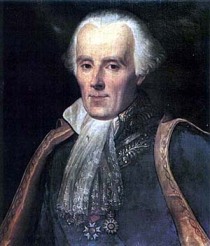
 Emphasizing
precise experimental work, Pierre Simon Laplace and his followers
aimed to develop a new universal physics based on a hypothesis of molecular
motions and forces. According to this view, all physical and chemical phenomena
could be explained in terms of short range forces between particles; aggregations
of different types of particles formed the so-called imponderables (light, heat,
magnetism, and electricity). As a result, Laplace and his followers considered
this way of doing physics to be applicable not only to problems of mechanics,
but also to optical, thermal, and electrical phenomena.
Emphasizing
precise experimental work, Pierre Simon Laplace and his followers
aimed to develop a new universal physics based on a hypothesis of molecular
motions and forces. According to this view, all physical and chemical phenomena
could be explained in terms of short range forces between particles; aggregations
of different types of particles formed the so-called imponderables (light, heat,
magnetism, and electricity). As a result, Laplace and his followers considered
this way of doing physics to be applicable not only to problems of mechanics,
but also to optical, thermal, and electrical phenomena.
According to the historian of science Paul Harman, this view of the physical universe as comprised of particles and forces acting on each other lent itself well to mathematicization of the Laplacian sort (that is, to the use of differentials). Differential techniques were not widely used in England until the early nineteenth century; instead, most English mathematicians and natural philosophers followed Newton in using the method of fluxions. In France, however, differential techniques allowed Laplace and his colleagues to develop equations for optical refraction, heat conduction, electrostatics, capillary action, and elastic behavior of solids. By viewing force-bearing imponderable fluids as comprised of infinitesimal elements whose combined influence on distant points could be calculated by integration, and by constructing apparatus to measure these forces, Laplacians developed quantitative theories of all the imponderables.
Although many of these theories appeared in Laplace's own work (notably his Traité de Méchanique Céleste, 1799-1825), Laplace enlisted the aid of many others, including such celebrated figures as Jean-Baptiste Biot, Joseph Gay-Lussac, and Siméon-Denis Poisson, in extending his unique vision of physical research. And although, as Robert Fox has pointed out, Laplacian physics never enjoyed universal success, and receded in influence quite noticeably after 1820, Laplace's influence remains significant insofar as Laplace and his followers provided a major spur to physical research all over Europe in the early part of the nineteenth century.
Last modified 28 September 2002